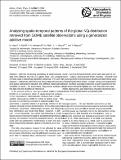| dc.contributor.author | Hayn, M. | |
| dc.contributor.author | Beirle, S. | |
| dc.contributor.author | Hamprecht, Fred A. | |
| dc.contributor.author | Menze, Bjoern Holger | |
| dc.contributor.author | Wagner, T. | |
| dc.date.accessioned | 2011-08-17T18:35:18Z | |
| dc.date.available | 2011-08-17T18:35:18Z | |
| dc.date.issued | 2009-09 | |
| dc.date.submitted | 2009-08 | |
| dc.identifier.issn | 1680-7324 | |
| dc.identifier.issn | 1680-7316 | |
| dc.identifier.uri | http://hdl.handle.net/1721.1/65186 | |
| dc.description.abstract | With the increasing availability of observational data from different sources at a global level, joint analysis of these data is becoming especially attractive. For such an analysis – oftentimes with little prior knowledge about local and global interactions between the different observational variables at hand – an exploratory, data-driven analysis of the data may be of particular relevance.
In the present work we used generalized additive models (GAM) in an exemplary study of spatio-temporal patterns in the tropospheric NO2-distribution [NO subscript 2 -distribution] derived from GOME satellite observations (1996 to 2001) at global scale. We focused on identifying correlations between NO2 [NO subscript 2] and local wind fields, a quantity which is of particular interest in the analysis of spatio-temporal interactions. Formulating general functional, parametric relationships between the observed NO2 [NO subscript 2] distribution and local wind fields, however, is difficult – if not impossible. So, rather than following a model-based analysis testing the data for predefined hypotheses (assuming, for example, sinusoidal seasonal trends), we used a GAM with non-parametric model terms to learn this functional relationship between NO2 [NO subscript 2] and wind directly from the data.
The NO2 [NO subscript 2] observations showed to be affected by wind-dominated processes over large areas. We estimated the extent of areas affected by specific NO2 [NO subscript 2] emission sources, and were able to highlight likely atmospheric transport "pathways". General temporal trends which were also part of our model – weekly, seasonal and linear changes – showed to be in good agreement with previous studies and alternative ways of analysing the time series. Overall, using a non-parametric model provided favorable means for a rapid inspection of this large spatio-temporal NO2 [NO subscript 2] data set, with less bias than parametric approaches, and allowing to visualize dynamical processes of the NO2 [NO subscript 2] distribution at a global scale. | en_US |
| dc.description.sponsorship | German Academy of Sciences Leopoldina (Leopoldina Fellowship Programme LPDS 2009-10) | en_US |
| dc.language.iso | en_US | |
| dc.publisher | European Geosciences Union / Copernicus | en_US |
| dc.relation.isversionof | http://dx.doi.org/10.5194/acp-9-6459-2009 | en_US |
| dc.rights | Creative Commons Attribution 3.0 | en_US |
| dc.rights.uri | http://creativecommons.org/licenses/by/3.0 | en_US |
| dc.source | Copernicus | en_US |
| dc.title | Analysing spatio-temporal patterns of the global NO2-distribution [NO subscript 2 -distribution] retrieved from GOME satellite observations using a generalized additive model | en_US |
| dc.type | Article | en_US |
| dc.identifier.citation | Hayn, M. et al. “Analysing Spatio-temporal Patterns of the Global NO2-distribution Retrieved from GOME Satellite Observations Using a Generalized Additive Model.” Atmospheric Chemistry and Physics 9.17 (2009) : 6459-6477. © Author(s) 2009 | en_US |
| dc.contributor.department | Massachusetts Institute of Technology. Computer Science and Artificial Intelligence Laboratory | en_US |
| dc.contributor.approver | Menze, Bjoern Holger | |
| dc.contributor.mitauthor | Menze, Bjoern Holger | |
| dc.relation.journal | Atmospheric Chemistry and Physics | en_US |
| dc.eprint.version | Final published version | en_US |
| dc.type.uri | http://purl.org/eprint/type/JournalArticle | en_US |
| eprint.status | http://purl.org/eprint/status/PeerReviewed | en_US |
| dspace.orderedauthors | Hayn, M.; Beirle, S.; Hamprecht, F. A.; Platt, U.; Menze, B. H.; Wagner, T. | en |
| mit.license | PUBLISHER_CC | en_US |
| mit.metadata.status | Complete | |
